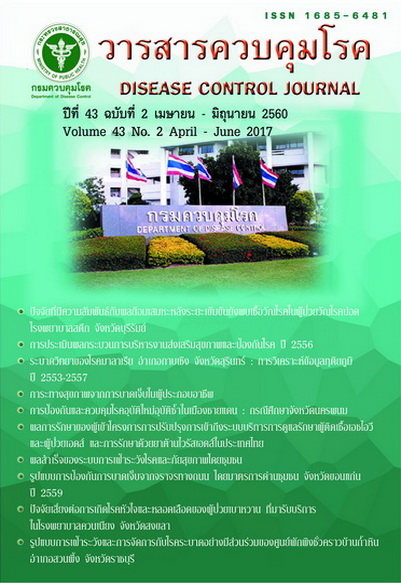Treatment outcomes of patients in the National Access to Antiretroviral Program for people living with HIV/AIDS, the Extension Phase (NAPHA Extension)
DOI:
https://doi.org/10.14456/dcj.2017.26Keywords:
treatment outcomes, antiretroviral treatment, HIV/AIDSAbstract
National Access to Antiretroviral Program for people living with HIV/AIDS was established in 2004 in order to increase access of patients to antiretroviral drugs; and extension of the program or NAPHA Extension was implemented in 2006. Its target group was the patients who were uninsured and with limited rights. This study aimed to evaluate treatment outcomes of the patients. It was conducted as a descriptive study using secondary data of the NAPHA Extension program’s database from October 2006 to September 2015. Patients aged <15 years or pregnant women or patients enrolled in the program for PMTCT were excluded from this study. It was found that cumulative number of patients registered in the program was 7,026. Of these, 52.4% were female and 47.6% were male. The mean age was 35 years (SD = 8.4). Most of them were migrants (61.7%). Altogether 70.3% of ARV naïve patients had CD4 level before starting antiretroviral treatment (ART) <200 cells/mm3. Viral load (VL) testing coverage to assess treatment outcome at the first year after ART initiation increased from 3.9% of patients in 2006 to 30.2% in 2014. Proportion of patients with VL suppression (VL <50 copies/ml) increased from 75.0% in 2006 to 84.3% in 2014. Death rate was 4.0% in 2015. Loss to follow-up >90 days after the last appointment date rose from 5.3% in 2006 to 50.5% in 2015. It can be concluded that effectiveness in the first year after ART had increased. However, treatment delay was observed. Furthermore, loss to follow-up rate had increased and VL testing coverage rates were still low. Promotion of early HIV testing and prompted ART were recommended. In addition, quality improvement of services to increase VL testing coverage, counseling and closed monitoring of patients to prevent drop-outs should be conducted.
References
2. Chasombat S, Lertpiriyasuwat C, Thanprasertsuk S, Suebsaeng L, Lo YR. The National Access to Antiretroviral Program for PHA (NAPHA) in Thailand. Southeast Asian J Trop Med Public Health 2006;37:704-15.
3. Lolekha R, Chunwimaleung S, Hansudewechakul R, Leawsrisook P, Prasitsuebsai W, Srisamang P, et al. Pediatric HIVQUAL-T: measuring and improving the quality of pediatric HIV care in Thailand, 2005-2007. Joint Commission Journal on Quality and Patient Safety 2010;36:541-51.
4. McConnell MS, Chasombat S, Siangphoe U, Yuktanont P, Lolekha R, Pattarapayoon N, et al. National program scale-up and patient outcomes in a pediatric antiretroviral treatment program, Thailand, 2000-2007. J Acquir Immune Defic Syndr 2010;54:423-9.
5. กรมควบคุมโรค, สำนักงานหลักประกันสุขภาพแห่งชาติ. ระบบบริการข้อมูลสารสนเทศ การให้บริการผู้ติดเชื้อ/ผู้ป่วยเอดส์ [อินเทอร์เน็ต]. [สืบค้นเมื่อ 9 พ.ย. 2559]. แหล่งข้อมูล: http://napdl.nhso.go.th/NAPPWebReport/jsp/new_home.jsp
6. กลุ่มโรคเอดส์ สำนักโรคเอดส์ วัณโรค และโรคติดต่อทางเพศสัมพันธ์. หนังสือกลุ่มโรคเอดส์ สำนักโรคเอดส์ วัณโรค และโรคติดต่อทางเพศสัมพันธ์ ที่ สธ 0424.4/7/GF2195 ลงวันที่ 14 มิถุนายน 2549 เรื่อง ขออนุมัติโครงการการปรับปรุงการเข้าถึงบริการการดูแลรักษาผู้ติดเชื้อและผู้ป่วยเอดส์ และการรักษาด้วยยาต้านไวรัสเอดส์ ปีที่ 3 (1 ตุลาคม 2548-30 กันยายน 2549) และแผนดำเนินงานโครงการ.
7. สมบัติ แทนประเสริฐสุข, สัญชัย ชาสมบัติ, พรทิพย์ ยุกตานนท์, ณัฐพร ก้องสกุลไกร, กมล เกษธรรม. โครงการปรับปรุงการเข้าถึงระบบบริการการดูแลรักษาผู้ติดเชื้อเอชไอวีและผู้ป่วยเอดส์ และการรักษาด้วยยาต้านไวรัสเอดส์ในประเทศไทย สำหรับผู้ป่วยที่มีข้อจำกัดในการเข้าถึงสิทธิ และผู้ป่วยที่อยู่นอกสิทธิระบบประกันสุขภาพ. วารสารควบคุมโรค 2555; 38:97-108.
8. สำนักโรคเอดส์ วัณโรค และโรคติดต่อทางเพศสัมพันธ์. โครงการกองทุนโลก ด้านการดูแลรักษา [อินเทอร์เน็ต]. [สืบค้นเมื่อ 30 ต.ค. 2559]. แหล่งข้อมูล: http://www.gfaidscare.com/naphax/
9. กองระบาดวิทยา สำนักงานปลัดกระทรวงสาธารณสุข. นิยามผู้ป่วยโรคเอดส์และผู้ติดเชื้อเอดส์ที่มีอาการที่ใช้ในการเฝ้าระวังโรค. กรุงเทพมหานคร: องค์การสงเคราะห์ทหารผ่านศึก; 2536.
10. สำนักโรคเอดส์ วัณโรค และโรคติดต่อทางเพศสัมพันธ์. แนวทางการตรวจรักษาและป้องกันการติดเชื้อเอชไอวี ประเทศไทย ปี 2557. กรุงเทพมหานคร: ชุมนุมสหกรณ์การเกษตรแห่งประเทศไทย; 2557.
11. World Health Organization. Consolidated guidelines on the use of antiretroviral drugs for treating and preventing HIV infection: recommendations for a public health approach. Geneva: World Health Organization; 2013.
12. UNAIDS. 90–90–90 An ambitious treatment target to help end the AIDS epidemic [Internet]. [cited 2016 Nov 15]. Available from: http://www.unaids.org/en/ resources/documents/2014/90-90-90
13. กรมควบคุมโรค, สำ นักงานหลักประกันสุขภาพแห่งชาติ. รายงานผลการดำเนินงาน Global AIDS Response Progress Reporting: การรักษาและติดตามผลการให้บริการผู้ติดเชื้อเอชไอวี/ผู้ป่วยเอดส์ [อินเทอร์เน็ต]. [สืบค้นเมื่อ 9 พ.ย. 2559]. แหล่งข้อมูล: http://napdl.nhso.go.th/NAPPWebReport/report/new_report_garp4.jsp
Downloads
Published
How to Cite
Issue
Section
License
Articles published in the Disease Control Journal are considered as academic work, research or analysis of the personal opinion of the authors, not the opinion of the Thailand Department of Disease Control or editorial team. The authors must be responsible for their articles.



.png)



